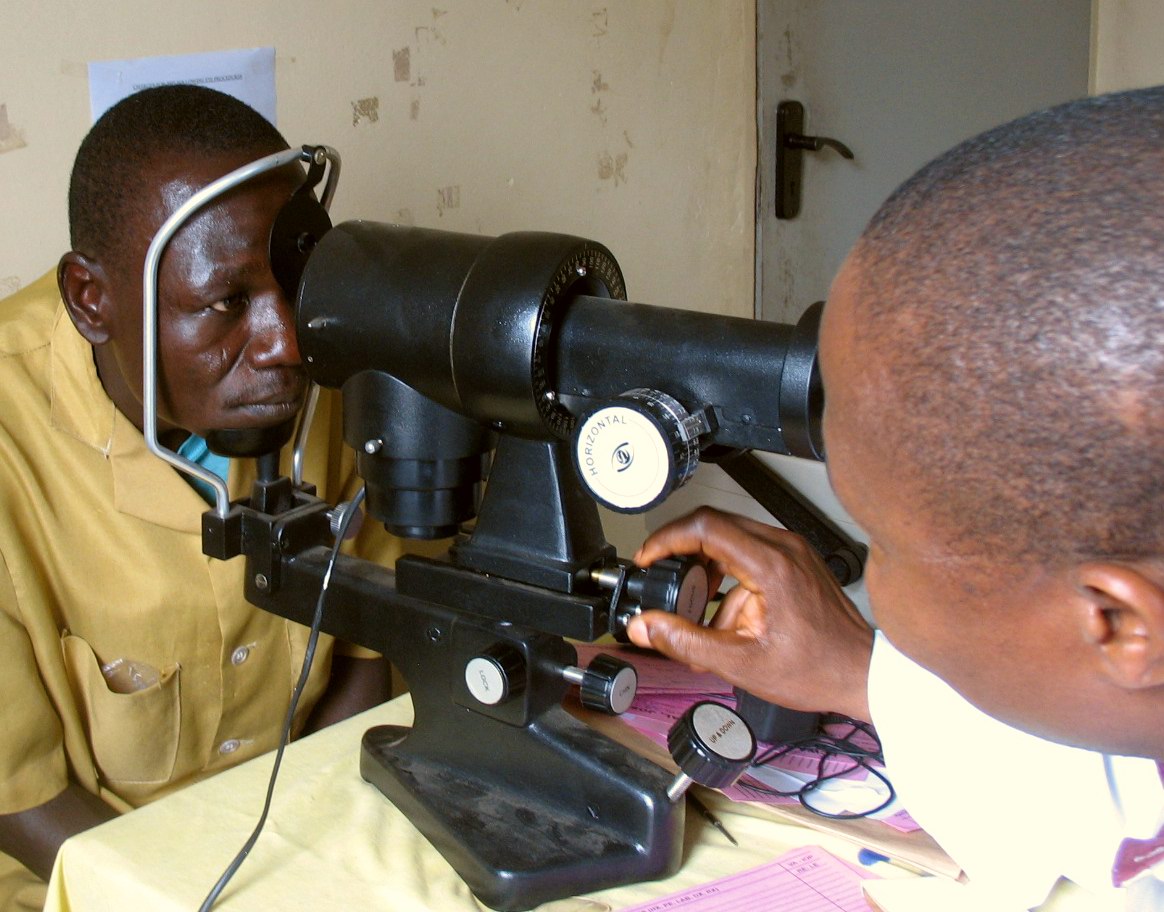|
Radial Keratotomy
Radial keratotomy (RK) is a refractive surgery, refractive surgical procedure to correct myopia (nearsightedness). It was developed in 1974 by Svyatoslav Fyodorov, a Russian Ophthalmology, ophthalmologist. It has been largely supplanted by newer, more accurate operations, such as photorefractive keratectomy, LASIK, Epi-LASIK and the Intraocular lens#Intraocular lenses for correcting refractive errors, phakic intraocular lens. Procedure When performing RK, incisions are made with a diamond knife. The incisions relax the steep central cornea in patients with myopia in order to achieve a decreased need for correction. The original technique – consisting of incisions from periphery to center – was called the "Russian technique", while the later advances of performing controlled incision from center to periphery was called the "American technique".Gulani AC, Fyodorov S: Future Directions in Vision course, June 1997 RK may be performed with different types, numbers, and patterns of ... [...More Info...] [...Related Items...] OR: [Wikipedia] [Google] [Baidu] |
Refractive Surgery
Refractive surgery is an optional eye surgery used to improve the refractive state of the eye and decrease or eliminate dependency on glasses or contact lenses. This can include various methods of surgical remodeling of the cornea ( keratomileusis), lens implantation or lens replacement. The most common methods today use excimer lasers to reshape the curvature of the cornea. Refractive eye surgeries are used to treat common vision disorders such as myopia, hyperopia, presbyopia and astigmatism. History The first theoretical work on the potential of refractive surgery was published in 1885 by Hjalmar August Schiøtz, an ophthalmologist from Norway. In 1930, the Japanese ophthalmologist Tsutomu Sato made the first attempts at performing this kind of surgery, hoping to correct the vision of military pilots. His approach was to make radial cuts in the cornea, correcting effects by up to 6 diopters. The procedure unfortunately produced a high rate of corneal degeneration, ... [...More Info...] [...Related Items...] OR: [Wikipedia] [Google] [Baidu] |
Beck Weathers
Seaborn Beck Weathers (born December 16, 1946) is an American pathologist from Texas who survived the 1996 Mount Everest disaster. His story was covered in Jon Krakauer's book ''Into Thin Air'' (1997), its film adaptation '' Into Thin Air: Death on Everest'' (1997), and the films ''Everest'' (1998) and ''Everest'' (2015). His autobiographical book, titled ''Left for Dead: My Journey Home from Everest'' (2000) includes his ordeal, but also describes his life before and afterward, as he focused on saving his damaged relationships. Early life and personal life Weathers was born in a military family. He attended college in Wichita Falls, Texas, married, and had two children. In 1986, he enrolled in a mountaineering course and later decided to try to climb the Seven Summits. He considered Richard Bass, the first man to climb the Seven Summits, an "inspiration" who made summitting Everest seem possible for "regular guys". In 1993, he was making a guided ascent on Vinson Massif, where ... [...More Info...] [...Related Items...] OR: [Wikipedia] [Google] [Baidu] |
Health In The Soviet Union
Health has a variety of definitions, which have been used for different purposes over time. In general, it refers to physical and emotional well-being, especially that associated with normal functioning of the human body, absent of disease, pain (including mental pain), or injury. Health can be promoted by encouraging healthful activities, such as regular physical exercise and adequate sleep, and by reducing or avoiding unhealthful activities or situations, such as smoking or excessive Stress (biology), stress. Some factors affecting health are due to Agency (sociology), individual choices, such as whether to engage in a high-risk behavior, while others are due to Social structure, structural causes, such as whether the society is arranged in a way that makes it easier or harder for people to get necessary healthcare services. Still, other factors are beyond both individual and group choices, such as genetic disorders. History The meaning of health has evolved over time. In k ... [...More Info...] [...Related Items...] OR: [Wikipedia] [Google] [Baidu] |
Russian Inventions
This timeline of Russian innovation encompasses key events in the history of technology in Russia. The entries in this timeline fall into the following categories: * indigenous invention, like airliners, AC transformers, radio receivers, television, artificial satellites, ICBMs * uniquely Russian products, objects and events, like Saint Basil's Cathedral, Matryoshka dolls, Russian vodka * products and objects with superlative characteristics, like the Tsar Bomba, the AK-47, and the Typhoon-class submarine * scientific and medical discoveries, like the periodic law, vitamins and stem cells This timeline includes scientific and medical discoveries, products and technologies introduced by various peoples of Russia and its predecessor states, regardless of ethnicity, and also lists inventions by naturalized immigrant citizens. Certain innovations achieved internationally may also appear in this timeline in cases where the Russian side played a major role in such projects. ... [...More Info...] [...Related Items...] OR: [Wikipedia] [Google] [Baidu] |
Visual Acuity
Visual acuity (VA) commonly refers to the clarity of visual perception, vision, but technically rates an animal's ability to recognize small details with precision. Visual acuity depends on optical and neural factors. Optical factors of the eye influence the sharpness of an image on its retina. Neural factors include the health and functioning of the retina, of the neural pathways to the brain, and of the interpretative faculty of the brain. The most commonly referred-to visual acuity is ''distance acuity'' or ''far acuity'' (e.g., "20/20 vision"), which describes someone's ability to recognize small details at a far distance. This ability is compromised in people with myopia, also known as short-sightedness or near-sightedness. Another visual acuity is ''Near visual acuity, near acuity'', which describes someone's ability to recognize small details at a near distance. This ability is compromised in people with hyperopia, also known as long-sightedness or far-sightedness. A com ... [...More Info...] [...Related Items...] OR: [Wikipedia] [Google] [Baidu] |
Cornea
The cornea is the transparency (optics), transparent front part of the eyeball which covers the Iris (anatomy), iris, pupil, and Anterior chamber of eyeball, anterior chamber. Along with the anterior chamber and Lens (anatomy), lens, the cornea Refraction, refracts light, accounting for approximately two-thirds of the eye's total optical power. In humans, the refractive power of the cornea is approximately 43 dioptres. The cornea can be reshaped by surgical procedures such as LASIK. While the cornea contributes most of the eye's focusing power, its Focus (optics), focus is fixed. Accommodation (eye), Accommodation (the refocusing of light to better view near objects) is accomplished by changing the geometry of the lens. Medical terms related to the cornea often start with the prefix "''wikt:kerat-, kerat-''" from the Ancient Greek, Greek word κέρας, ''horn''. Structure The cornea has myelinated, unmyelinated nerve endings sensitive to touch, temperature and chemicals; a to ... [...More Info...] [...Related Items...] OR: [Wikipedia] [Google] [Baidu] |
Pupil
The pupil is a hole located in the center of the iris of the eye that allows light to strike the retina.Cassin, B. and Solomon, S. (1990) ''Dictionary of Eye Terminology''. Gainesville, Florida: Triad Publishing Company. It appears black because light rays entering the pupil are either absorbed by the tissues inside the eye directly, or absorbed after diffuse reflections within the eye that mostly miss exiting the narrow pupil. The size of the pupil is controlled by the iris, and varies depending on many factors, the most significant being the amount of light in the environment. The term "pupil" was coined by Gerard of Cremona. In humans, the pupil is circular, but its shape varies between species; some cats, reptiles, and foxes have vertical slit pupils, goats and sheep have horizontally oriented pupils, and some catfish have annular types. In optical terms, the anatomical pupil is the eye's aperture and the iris is the aperture stop. The image of the pupil as seen from o ... [...More Info...] [...Related Items...] OR: [Wikipedia] [Google] [Baidu] |
Astigmatism
Astigmatism is a type of refractive error due to rotational asymmetry in the eye's refractive power. The lens and cornea of an eye without astigmatism are nearly spherical, with only a single radius of curvature, and any refractive errors present can be corrected with simple glasses. In an eye with astigmatism, either the lens or the cornea is slightly egg-shaped, with higher curvature in one direction than the other. This gives distorted or blurred vision at any distance and requires corrective lenses that apply different optical powers at different rotational angles. Astigmatism can lead to symptoms that include eyestrain, headaches, and trouble driving at night. Astigmatism often is present at birth, but can change or develop later in life. If it occurs in early life and is left untreated, it may result in amblyopia. The cause of astigmatism is unclear, although it is believed to be partly related to genetic factors. The underlying mechanism involves an irregular c ... [...More Info...] [...Related Items...] OR: [Wikipedia] [Google] [Baidu] |
Keratoconus
Keratoconus is an eye disorder in which the cornea, the transparent front part of the eye, gradually thins and bulges outward into a cone shape. This causes distorted vision, including blurry vision, double vision, increased nearsightedness, irregular astigmatism, and light sensitivity, which can reduce Quality of life (healthcare), quality of life. Both eyes are usually affected. The cause is not fully understood but likely involves a combination of heredity, genetic, environmental, and hormonal factors. Having a parent, sibling, or child with keratoconus increases risk significantly. Environmental risk factors include frequent eye rubbing and atopy, allergies. Diagnosis is typically made with corneal topography, which maps the shape of the cornea and reveals characteristic changes. In early stages, vision is often corrected with glasses or soft contact lenses. As the condition progresses, rigid or scleral contact lenses may be needed. In 2016, the FDA approved corneal col ... [...More Info...] [...Related Items...] OR: [Wikipedia] [Google] [Baidu] |
Tsutomu Sato (ophthalmologist)
Tsutomu Sato (1902 – June 9, 1960) was a Japanese ophthalmologist who performed an early version of the radial keratotomy and was the first professor at the Research Institute of Ophthalmology at Juntendo University School of Medicine. Biography Sato was the first professor at the Research Institute of Ophthalmology at Juntendo University School of Medicine, where he researched the treatment of eye conditions such as trachoma and myopia. In the mid-1930s, Sato devised a glass scleral lens, but it never came into wide usage. Within a few years, higher-quality glass scleral lenses from Carl Zeiss were available in Japan. In 1939, Sato became the first physician to report the use of radial keratotomy for myopia. Sato knew that the cornea flattened out in patients with keratoconus who suffered corneal hydrops from the leakage of fluid through Descemet's membrane. His idea was to create numerous breaks in that membrane through anterior and posterior approaches. His initial patients ... [...More Info...] [...Related Items...] OR: [Wikipedia] [Google] [Baidu] |
Keratometer
A keratometer, also known as an ophthalmometer, is a diagnostic instrument for measuring the curvature of the anterior surface of the cornea, particularly for assessing the extent and axis of astigmatism. It was invented by the German physiologist Hermann von Helmholtz in 1851, although an earlier model was developed in 1796 by Jesse Ramsden Jesse Ramsden Fellow of the Royal Society, FRS FRSE (6 October 1735 – 5 November 1800) was a British mathematician, astronomy, astronomical and scientific instrument maker. His reputation was built on the engraving and design of dividing engine ... and Everard Home. A keratometer uses the relationship between object size (O), image size (I), the distance between the reflective surface and the object (d), and the radius of the reflective surface (R). If three of these variables are known (or fixed), the fourth can be calculated using the formula :R = 2d \frac{O} There are two distinct variants of determining R; Javal-Schiotz type ke ... [...More Info...] [...Related Items...] OR: [Wikipedia] [Google] [Baidu] |






